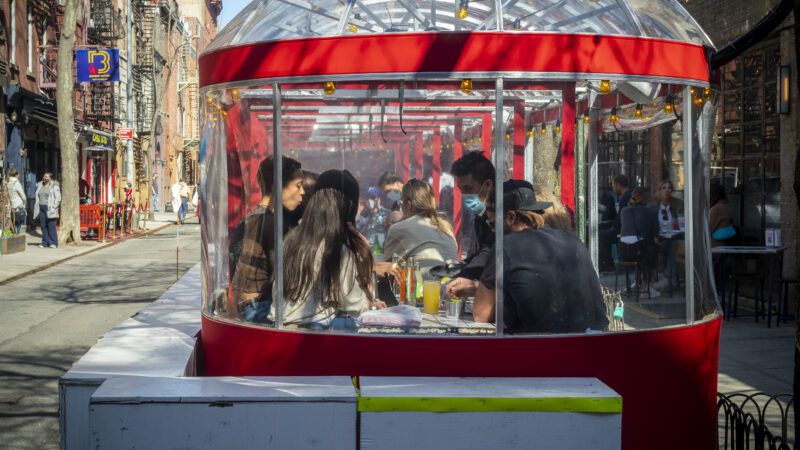Lingering COVID Requirements for NYC Bars and Restaurants Amount to Pointless Hygiene Theater
Theatrical safety checks don't keep people safe—vaccines do.

In a city where 62.8 percent of adults have received their first COVID-19 vaccine dose, and 54.4 percent of adults are fully vaccinated, it makes little sense why New York City's governing bodies continue to exercise heavy-handed control over what private restaurants and bars do to protect their patrons from COVID. It makes even less sense when you consider the specific regulations still in place, and how many of them are relics of a form of shoddy hygiene theater that made some limited amount of sense earlier in the pandemic, before we knew how the virus worked, but are not scientifically justified now.
Current guidance, updated most recently on May 7, requires that temperature checks be conducted upon arrival and that tables remain spaced six feet apart from each other (or have pointless plexiglass barriers, which "must be at least five feet in height," for some reason, installed between booths). As of May 19, restaurants may finally reopen at full capacity for the first time since March 2020—a welcome opportunity for entrepreneurs whose businesses have been crippled by lockdowns and patchwork reopening guidance—but the regulations placed on them make very little sense. For some New York restaurants, the requirement to keep tables six feet apart from each other will even make it so they cannot truly operate at full capacity if they want to remain in compliance.
Customers are finally allowed to sit at the bar, but only "provided a distance of at least six feet can be maintained between parties (i.e., groups of patrons)." Bar and restaurant proprietors are still expected to "put in place measures to reduce bi-directional foot traffic…by using tape or signs with arrows in narrow aisles, hallways, or spaces," placing "distance markers denoting spaces of six feet in all commonly used areas."
Though the nonsensical midnight curfews for indoor and outdoor dining have finally been lifted citywide, many other pointless measures remain in place. Just as they've been forced to for the last 15 months, business owners must continue to navigate a maze of state- and city-imposed restrictions that fail to take into account the idea that maybe they're the ones best suited to decide what works for their own staff and customers.
Some hygiene measures are thankfully beginning to be lifted: The state's mask mandates are no longer in place indoors if restaurants require proof of vaccination for staff and customers. For those customers, too, distancing requirements are no longer in place, but it's logistically incredibly difficult for businesses to verify that and to implement different policies for vaccinated and unvaccinated patrons (who might even be in the same party). Midnight curfews, which never made sense since they forced people to convene within a shorter timeframe (and sometimes even shifted revelry indoors to cramped apartments), were lifted for outdoor dining in mid-May, and for indoor dining just a few days ago.
It's fine for private businesses to take measures to restore a degree of confidence for their more skittish customers so that they will finally venture out into the world. But the measures that many of them have implemented, both those mandated by law and those voluntarily opted into because they're standard practice expected by anxious customers, are not actually particularly useful for preventing the spread of COVID, a virus we now know a lot about.
Consider temperature checks, which only screen for one COVID symptom, which may or may not be present if someone is contagious; plexiglass barriers, which do not make sense for a virus that spreads via airborne transmission of aerosols; markers on the floor, which direct people through separate entrances and exits and do not make sense for a virus that is spread through longer-duration close contact (not few-second encounters); the theatrical practice of masking up to enter a restaurant, then walking to your table and keeping your mask off for the rest of the evening, the part with talking and laughing, donning it only to use the bathroom (where, for New York's many single-occupancy facilities, you will not run into a single other soul unless you invite them).
Though these remnants of hygiene theater may seem like trivial inconveniences not worth forcefully opposing, it would be wrong to keep in place measures that make people feel safe but actually spread bad information about how this virus spreads. Getting vaccinated provides the best protection; plexiglass barriers and entrance/exit floor markers won't do the trick.

Show Comments (33)